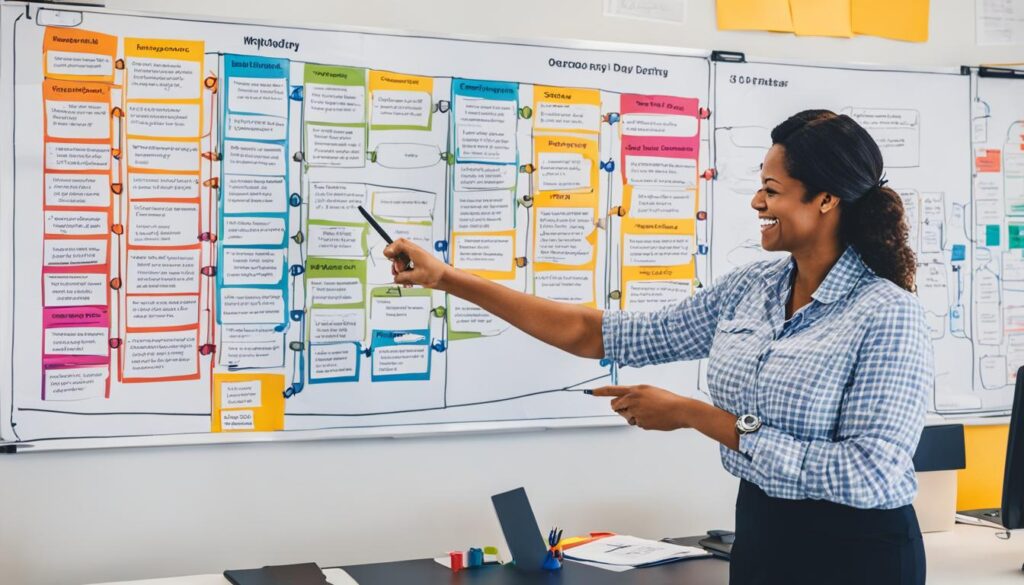Welcome to our comprehensive onboarding guide for customer service workers. In this article, we will explore the importance of onboarding new hires and provide you with a 30-60-90 day onboarding plan template. Effective onboarding is crucial for creating a strong customer service department, ensuring that new hires are equipped with the knowledge and skills to represent your brand and provide exceptional service to customers.
During the onboarding process, new customer service representatives will become familiar with your company’s policies, tools, and culture. They will learn how to effectively handle customer interactions, address inquiries, and resolve issues. By investing in a comprehensive onboarding plan, you can improve customer experiences, satisfaction, and ultimately, your company’s reputation.
Continue reading to discover the importance of onboarding customer service agents and the key elements of the 30-60-90 day onboarding plan. Let’s dive in!
Key Takeaways:
- Onboarding new customer service representatives is crucial for creating a strong and effective customer service department.
- An effective onboarding process ensures that new hires are familiar with the company’s policies, tools, and culture.
- The 30-60-90 day onboarding plan outlines specific goals, learning actions, performance actions, and key metrics for new hires to achieve during their onboarding period.
- Neglecting the onboarding process can result in higher turnover rates and poorly trained agents who may not meet customer expectations.
- Preparing for onboarding involves gathering necessary documentation, setting up accounts and access rights, and updating company policies and training processes.
The Importance of Onboarding Customer Service Agents
When it comes to building a successful customer service department, onboarding your agents is absolutely crucial. This process plays a vital role in helping new hires understand their responsibilities, align with company policies, and integrate seamlessly into the workplace culture. Effective onboarding ensures that your customer service representatives are approachable, knowledgeable, and equipped to deliver exceptional service to your customers. By investing in comprehensive onboarding, you can significantly impact customer experiences, satisfaction levels, and ultimately, your company’s reputation.
Neglecting the onboarding process can have detrimental effects. Without proper training and orientation, new agents may struggle to meet customer expectations, leading to higher turnover rates and a negative impact on your company’s bottom line. Don’t underestimate the importance of customer service training and orientation – it’s an investment that pays off in the long run.
The Benefits of Onboarding Customer Service Agents
- Clear role understanding: Onboarding allows new hires to gain a thorough understanding of their role within the company, ensuring they know their responsibilities and expectations.
- Familiarity with policies and tools: By providing proper training, new agents can familiarize themselves with company policies, procedures, and tools, enabling them to navigate through different customer scenarios effectively.
- Integration into workplace culture: Onboarding helps new hires become a part of the team, aligning their values and work ethic with the company’s culture. This integration fosters collaboration and teamwork.
- Exceptional customer service: Well-trained and onboarded agents are more likely to provide exceptional customer service, improving customer experiences and satisfaction levels.
- Enhanced company reputation: Consistently delivering excellent customer service leads to a positive company reputation, attracting and retaining loyal customers.
An empowered and well-trained customer service team ensures exceptional customer experiences.
The 30-60-90 Day Onboarding Plan Template
When it comes to onboarding new customer service agents, a well-designed plan is essential for their successful transition into their roles. The 30-60-90 day onboarding plan is a comprehensive strategy that provides a roadmap for their first three months in the company. This plan incorporates specific goals, learning actions, performance actions, and key metrics to guide recruits throughout their onboarding journey.
The Learning Phase
The first phase of the onboarding plan is the learning phase, which spans the initial 30 days. During this time, new agents focus on building foundational knowledge and skills. They become familiar with the company’s policies, values, and standard operating procedures. Compliance and security training, as well as product training, are also completed to ensure a solid understanding of the company’s offerings and customer pain points. Additionally, new agents learn how to effectively use tools and software, handle customer complaints, and gather feedback.
The Collaborating Phase
Between days 31 and 60, new agents enter the collaborating phase of their onboarding journey. This phase emphasizes practical application and collaboration with colleagues. Agents have the opportunity to work with other teams and departments, gaining valuable experience in cross-functional collaboration. Role-specific training sessions further develop job-specific skills. Building relationships with an assigned onboarding buddy and seeking ongoing support from experienced agents helps integrate new agents into the team and foster a collaborative work environment.

The Leading Phase
The leading phase occurs between days 61 and 90 of the onboarding plan. At this stage, new agents are expected to work independently and take on leadership roles within the customer service team. They are well-acquainted with the company’s processes and can handle customer inquiries and issues with minimal supervision. Self-reflection and evaluation play a significant role during this phase, as new agents self-evaluate their progress and collaborate with supervisors on personalized employee development plans to support continuous professional growth.
The 30-60-90 day onboarding plan provides a structured framework that enables new customer service agents to successfully transition into their roles. By following this plan, companies can ensure that new agents acquire the necessary knowledge, skills, and independence to provide excellent customer service. Implementing customer service best practices and customer success onboarding techniques during the onboarding process contributes to the development of a strong and effective customer service team.
Preparing for Onboarding
Before the onboarding process begins, it is crucial to make necessary preparations. This ensures a smooth transition for new hires and sets the stage for a successful onboarding experience. Here are some key steps to take:
Gather the Required Documentation
Start by collecting all the necessary paperwork, contracts, and documentation for the new hires. This may include employment agreements, tax forms, and any other relevant legal documents. By having these materials ready, you can streamline the onboarding process and save time for both the new employee and the HR team.
Set up Accounts and Access Rights
To ensure a seamless onboarding experience, it’s essential to set up the new hires’ accounts and grant them the necessary access rights. This includes providing login credentials for relevant systems, such as email, internal tools, and customer management platforms. By ensuring that everything is ready beforehand, you can help new employees hit the ground running from day one.
Prepare the Hardware and Workspace
If the new hires require specific hardware or equipment to perform their roles, make sure it is ready and available before they start. This may include providing laptops, phones, or any other tools necessary for their job functions. Additionally, ensure that their workspaces are clean, organized, and set up with the required resources to make them feel welcomed and ready to work.
Notify the Customer Service Department
Take the time to inform the existing customer service team about the new member that will be joining their ranks. This simple gesture can help foster a welcoming and inclusive environment for the new hire. It also allows the team to prepare and support the incoming employee, reducing any potential awkwardness or disconnect in the workplace.
Update Company Policies and Content
Review and update any necessary company policies, training processes, compliance documentation, and role-specific content that is relevant to the new hires’ positions. This ensures that all materials are accurate, up-to-date, and aligned with the company’s expectations. By providing the most current information, you set the stage for the new employees’ success.
By following these steps, you can ensure that your organization is well-prepared for the onboarding process. This thoughtful preparation sets a positive tone and enables new employees to integrate seamlessly into the customer service department, contributing to their success and the overall success of the organization.
The Learning Phase
In the onboarding process for new customer service agents, the learning phase plays a crucial role. This phase, which spans the first 30 days, focuses on building the foundational knowledge and skills necessary for success in the role.
During the learning phase, new hires are encouraged to familiarize themselves with the company’s policies, corporate values, and standard operating procedures. This understanding is essential for providing consistent and aligned customer service. Completing compliance and security training ensures that agents adhere to industry regulations and maintain customer data privacy and security.
Product training is another vital component of the learning phase. It helps new agents understand the company’s offerings, customer personas, and recurring pain points. Gaining this knowledge enables agents to provide effective solutions and personalized support to customers.
Learning how to use tools and software specific to the customer service role is also an integral part of the learning phase. These tools enable agents to efficiently handle customer inquiries, access relevant information, and escalate complaints when necessary.
Additionally, collecting feedback is crucial during the learning phase. This feedback helps new agents identify areas for improvement and adapt their customer service approach accordingly. It also allows the organization to assess the effectiveness of the onboarding process and make any necessary adjustments.
By focusing on customer service training and implementing best practices during the learning phase, companies can ensure that their new customer service agents have the knowledge and skills needed to provide exceptional customer experiences.
The Collaborating Phase
The collaborating phase is a crucial stage in the onboarding process for new customer service agents. Occurring between days 31 and 60, this phase provides opportunities for agents to interact with other teams and departments, giving them invaluable experience in working with different stakeholders.
During the collaborating phase, new agents may participate in role-training sessions, enabling them to further develop their job-specific skills. This training helps agents understand the broader context of their role and how their work contributes to the overall success of the organization.
It is also important for new agents to check in regularly with their onboarding buddy. This individual serves as a mentor and provides ongoing support, helping new agents integrate into the team and build stronger relationships throughout the onboarding process.
The collaborating phase focuses on the practical application of knowledge and emphasizes collaboration with colleagues. By working with experienced agents and actively engaging with other teams, new agents can gain valuable insights and refine their customer service skills.
During this phase, agents may have the opportunity to work on cross-functional projects or participate in group exercises that simulate real-life customer scenarios. These collaborative experiences help agents build confidence, develop effective communication skills, and learn from the expertise of their peers.
By fostering collaboration and providing ongoing training and support, companies can ensure that new customer service agents become valuable contributors to the team, delivering exceptional service to customers and embodying customer service best practices.
The Leading Phase
The leading phase is the final stage of the onboarding process, occurring between days 61 and 90. In this phase, you will witness the growth and independence of new customer service agents as they gain confidence in their abilities. It is during this time that they may also have the opportunity to assume leadership roles within the team, showcasing their dedication and skills.
By now, new agents should have a solid understanding of the company’s processes and procedures, enabling them to handle customer service inquiries and issues with minimal supervision. They should be well-versed in the best practices for delivering excellent customer service, ensuring that each interaction leaves a positive impression. The training provided throughout the onboarding period would have equipped them with both the knowledge and skills required to excel in their roles.
Throughout the leading phase, self-reflection and evaluation are emphasized. New agents will have the opportunity to fill in self-evaluations, allowing them to assess their own performance and identify areas for improvement. This introspection is invaluable as it fosters personal and professional growth, helping them become more self-aware and continue to refine their customer service skills.
Collaboration and Development
Additionally, collaboration plays a vital role during the leading phase. New agents will collaborate on employee development plans with their supervisors and mentors. This collaborative effort aims to provide ongoing support and guidance, aligning individual goals with the overall objectives of the customer service department.
By actively participating in their own development and working closely with experienced colleagues, new agents can continue to enhance their customer service abilities and learn from others’ expertise. Collaboration within the team fosters a culture of continuous improvement and encourages the sharing of customer service best practices.
With the leading phase, the onboarding process reaches its culmination, ensuring that new customer service agents are equipped to take on their roles with confidence and proficiency. They have progressed from learning about the company and its policies to applying their knowledge independently, ready to deliver exceptional customer service experiences.

Throughout the onboarding journey, the leading phase serves as a pivotal point, marking the transition from being new hires to becoming valuable members of the customer service team. It sets the foundation for a successful and fulfilling career in customer service, promoting professionalism and continuous growth.
Conclusion
Customer service training is a critical aspect of creating a strong and effective customer service department. By providing new hires with the necessary guidance and support, companies can ensure that they represent the brand and deliver exceptional service to customers. Customer success onboarding, such as the 30-60-90 day plan, plays a vital role in helping new agents acclimate to their roles, understand company policies, develop product knowledge, and build essential skills for customer interactions.
Investing in comprehensive customer service orientation has numerous benefits. It not only improves customer experiences but also increases customer retention, leading to a stronger bottom line for the company. Effective onboarding ensures that customer service representatives are well-equipped to handle customer inquiries and provide resolution, resulting in higher satisfaction levels and a positive reputation for the organization.
In today’s competitive market, companies cannot afford to overlook the importance of customer service training. By prioritizing onboarding and providing new hires with the necessary training and support, organizations can set their customer service department up for success. Remember, a well-trained and customer-oriented team is the key to delivering outstanding service and building lasting customer relationships.
FAQ
Why is onboarding customer service agents important?
Onboarding customer service agents is important because it allows new hires to understand their role within the company, familiarize themselves with policies and tools, and integrate into the workplace culture. It ensures that customer service representatives are approachable, knowledgeable, and capable of delivering excellent service to customers.
What is the 30-60-90 day onboarding plan?
The 30-60-90 day onboarding plan is a comprehensive strategy that helps new customer service agents transition into their roles successfully. It consists of specific goals, learning actions, performance actions, and key metrics to guide recruits throughout their first three months in the company.
What should be done before the onboarding process begins?
Before the onboarding process begins, necessary preparations should include gathering required documentation, setting up accounts and access rights, notifying the customer service department, and updating company policies and training processes.
What is included in the learning phase of the onboarding process?
The learning phase of the onboarding process focuses on building foundational knowledge and skills for new customer service agents. This includes familiarizing themselves with the company’s policies, values, and procedures, completing compliance and security training, and receiving product training.
What happens during the collaborating phase?
The collaborating phase occurs between days 31 and 60 of the onboarding process. During this phase, new customer service agents start interacting with other teams, participate in role-training sessions, and receive ongoing support from experienced agents to integrate into the team and build relationships.
What is the leading phase of the onboarding process?
The leading phase is the final stage of the onboarding process, which occurs between days 61 and 90. During this phase, new customer service agents work independently, handle customer service inquiries with minimal supervision, and focus on self-reflection and evaluation to continue their professional growth.




